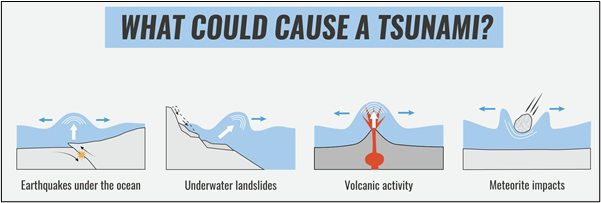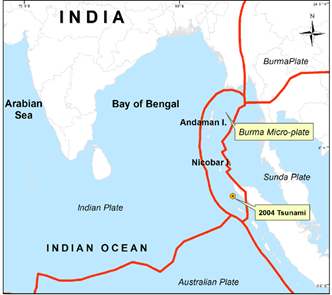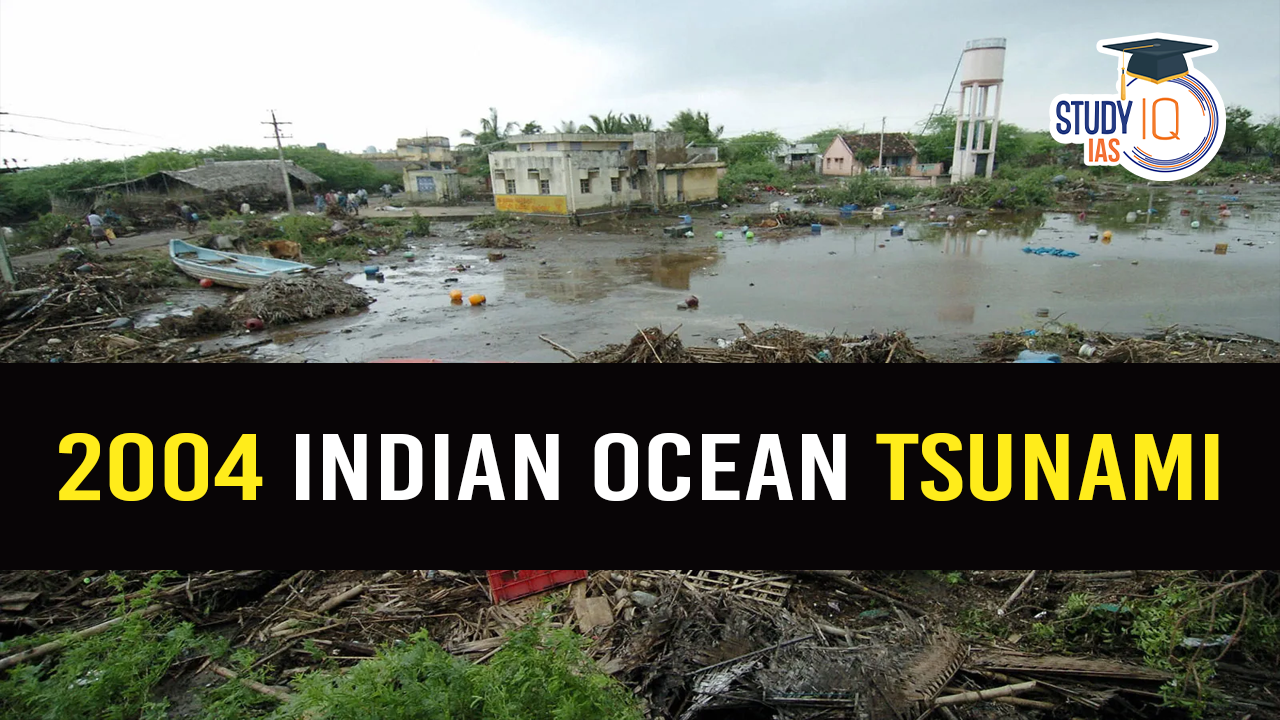Table of Contents
What is a Tsunami?
- Tsunami, often referred to as a seismic sea wave,is a series of large ocean waves caused by sudden and significant disturbances on the seafloor or near the ocean’s surface.
- The term “tsunami” originates from the Japanese words “tsu” (meaning harbor) and “nami” (meaning wave).

Causes of Tsunamis
- Undersea Earthquakes: The most common cause of tsunamis.
- Occurs when tectonic plates suddenly shift, causing vertical displacement of water.
- Typically associated with subduction zones, where one tectonic plate slides beneath another.
- Volcanic Eruptions: Volcanic explosions or the collapse of underwater volcanoes can displace large volumes of water.
- Example: The eruption of Krakatoa in 1883 caused a devastating tsunami.
- Landslides: Submarine landslides (underwater) or coastal landslides can create tsunamis.
- Example: The Lituya Bay tsunami (1958) was triggered by a massive landslide.
- Meteorite Impacts: Rare but catastrophic.
- Large meteors striking the ocean can generate tsunamis due to the sudden displacement of water.

| Facts |
|
Characteristics of Tsunamis
- Wave Speed: Tsunami waves can travel at speeds up to 800 km/h (similar to jet planes) in deep water.
- The speed decreases as the waves approach shallow coastal areas.

- Wavelength and Amplitude:
- In deep water: Long wavelengths (100-500 km) and low amplitudes (less than 1 meter), making them difficult to detect.
- Near the shore: Shorter wavelengths and significantly higher amplitudes (up to 30 meters or more) due to a phenomenon known as “wave shoaling.”
|
Facts |
|
- Multiple Waves: Tsunamis often occur as a series of waves (wave train) with intervals ranging from minutes to hours.
- The first wave is not always the largest or most destructive.
2004 Indian Ocean Tsunami
- On December 26, 2004, a massive earthquake measuring 9.1 in magnitude struck off the coast of Sumatra, Indonesia.
- This event was the third-largest earthquake recorded globally since 1900.
- The earthquake originated from a depth of 30 kilometers beneath the ocean floor, specifically in the Sunda Trench, where the Indo-Australian plate is subducting beneath the Burma microplate.

Indian Government Steps Post-Tsunami
- The Indian Tsunami Early Warning Centre (ITEWC), established in 2007 by the Union Ministry of the Earth Sciences of the Government of India.
- Operates from: Indian National Centre for Ocean Information Services (INCOIS) at Hyderabad.
- Capabilities:
- 24/7 monitoring of seismic and ocean data.
- Equipped with bottom pressure recorders (BPRs), tidal gauges, and seismological stations.
- Real-time analysis of data from IMD and 350 global seismic stations.
- Response Time: Capable of identifying a potential tsunami-triggering earthquake and issuing alerts within 10 minutes.
What are the 6 Critical Lessons From the 2004 Tsunami?
- Importance of Mangroves as Natural Buffers: Mangroves play a crucial role in protecting coastal areas by acting as natural barriers against waves and storm surges. Their destruction for economic activities like shrimp farming, tourism, and wood harvesting exacerbates disaster impacts.
- A study by UNEP (2005) highlighted that areas with dense mangrove forests experienced significantly lower tsunami damage. For example, coastal villages in Tamil Nadu with mangroves reported fewer casualties.
- As per the India State of Forest Report, 2023, mangrove cover in India is 4,991.68 km², representing a net decrease of 7.43 km² since 2021.
- Reforestation initiatives such as the Union government’s Mangrove Initiative for Shoreline Habitats & Tangible Incomes (MISHTI) programme to restore mangrove cover in India should be promoted.
- Keep Common Resources in Public Domain: Privatization of coastal lands displaces local communities and undermines traditional livelihoods, leading to socio-economic vulnerabilities.
- In Thailand, during the 1980s-90s, privatization led to the loss of public access to coastlines, with displaced communities transitioning to informal, low-paying jobs. This structural shift increased reliance on global economic trends, creating instability.
- In India, tourism-driven privatization of beaches in states like Goa and Kerala has raised similar concerns about displacing fishing communities.
- Economic Disruptions and Livelihood Shifts: Tsunamis disrupt local economies, creating winners and losers in the market. Traditional livelihoods, like artisanal fishing, are often replaced by mechanized methods, leading to environmental degradation.
- In Tamil Nadu, post-tsunami relief efforts pushed mechanized fishing, displacing traditional practices and intensifying over-fishing.
- Land prices in tsunami-hit areas rose sharply, benefiting asset owners but marginalizing displaced communities.
- A study in 2006 (by the Food and Agriculture Organization) revealed that 75% of Indian coastal fishing communities reported reduced income and increased dependence on external markets.
- Addressing Inequalities in Relief and Rehabilitation: Relief efforts often reflect and reinforce existing social inequalities, with marginalized groups receiving inadequate support.
- In Sri Lanka, Tamil minorities in the north and east received disproportionately less aid than other communities.
- In India, Dalit and tribal communities, who worked as laborers in fishing economies, were largely excluded from compensation packages.
- Gender Sensitivity in Relief and Rehabilitation: Women’s specific needs are often overlooked during disaster recovery, exacerbating their vulnerabilities.
- Women involved in fish processing and shell collection were excluded from relief measures as assets were registered in men’s names.
- Widows in fishing communities faced barriers to accessing assistance due to the lack of identity documentation.
- Engage with Local Structures for Resilient Recovery: Community-based local institutions, such as fishing cooperatives, play a critical role in organizing relief and maintaining resilience.
- Imposition of external democratic norms often disrupted community cohesion.
- Eg., Attempts to replace traditional cooperative practices with individual-based aid distribution led to increased tensions and dependency.
- A study in 2007 by the National Institute of Disaster Management (NIDM) emphasized the need for long-term engagement with local structures to address issues like gender inequality organically.
- Imposition of external democratic norms often disrupted community cohesion.



 Places in News for UPSC 2026 for Prelims...
Places in News for UPSC 2026 for Prelims...
 Lake Natron: Location, Features, Wildlif...
Lake Natron: Location, Features, Wildlif...
 Erra Matti Dibbalu Added to UNESCO Tenta...
Erra Matti Dibbalu Added to UNESCO Tenta...

























